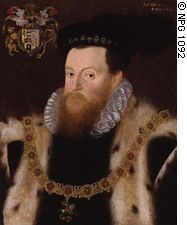
Sir Henry Sidney (by or after
Arnold van Brounckhorst, 1573).
Search the Archive
Add or Correct Items
History of Sidney Scholarship
Introduction to the Site
Guide for Browsers
Acknowledgements
Related Sites
Home
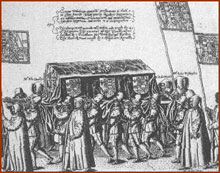 Sidney's Casket Sidney's Casket
(Thomas Lant, 1587)
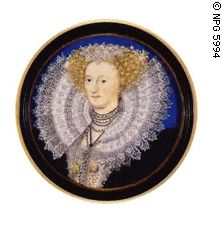
Mary Sidney, Countess of Pembroke
(Nicholas Hilliard, ca. 1590)
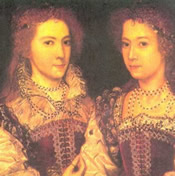
Penelope and Dorothy Devereux
(ca. 1581)
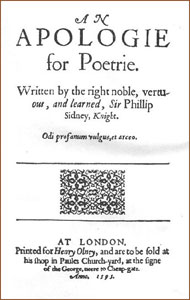
Title Page
(from the First (?) Edition
of Defence of Poetry)
|
History of Sidney Scholarship
Introduction: Sidney as a Rennaisance Man
When Sidney died in 1586 fighting against Catholic forces in the Netherlands, he was mourned in England and on the Continent as few Englishman below the ranks of royalty had ever been mourned. The Dutch honored him as a national hero, offering to build him a great monument and publishing nearly three dozen elegies in his memory. Many citizens gathered at the docks along with the twelve hundred English soldiers who came to see his coffin off on its journey to England. His own countrymen arranged one of the most elaborate funerals ever given an English subject and published a flood of elegies, including two volumes prepared at Oxford and one at Cambridge, which brought together the work of more than a hundred and forty contributors. Other memoirs and elegies were published separately by a long and distinguished list of mourners, including Barnabe Barnes, Richard Barnfield, Nicholas Breton, William Byrd, Thomas Campion, Thomas Churchyard, Henry Constable, Samuel Daniel, Michael Drayton, Fulke Greville, George Peele, Sir Walter Ralegh, Edmund Spenser, George and Bernard Whetstone, and Sidney's sister, the Countess of Pembroke.
To understand these extraordinary public expressions of grief and respect, one must not only consider what Sidney accomplished in his brief life but also what others hoped that he would accomplish. In a phrase later remembered by Charles Dickens, he once described himself as a man of "great expectations," and it is hard to think of any commoner of his generation who was born with more advantages or more promise. His mother, Lady Mary Sidney, was a Dudley, daughter of the Earl of Northumberland and sister-in-law to Lady Jane Grey. His father, Sir Henry Sidney, was a favorite of the young King Edward VI and was--at least at the time of Sidney's birth--extraordinarily wealthy, holding considerable property in his own right and standing as prospective heir to other land-holdings scattered through several counties of England. He later served Queen Elizabeth in several prominent posts, most notably as Lord Deputy of Ireland. Sir Philip's uncles, the earls of Leicester and Warwick, were among the most wealthy and powerful men in the realm, and he was also connected to influential circles at court through his marriage to the daughter of Elizabeth's great secretary, Sir Francis Walsingham.
Throughout his life, Sidney hoped that his expectations would be fulfilled in high office and in great affairs of state. Indeed, from 1575 to 1585, he played limited but visible roles as a courtier, an ambassador, a member of Parliament, and a joint Master of Ordnance, helping to fortify Dover and the coast against the expected invasion of the Spanish Armada. Unfortunately, however, he was too impetuous and too outspoken--particularly in supporting the radical Protestant faction surrounding his uncle, the Earl of Leicester--to gain the confidence of the Queen. In consequence, he was never given responsibilities that matched either his abilities or his connections at court. Though many prominent leaders in England and on the Continent regarded him as a promising candidate to lead an international Protestant League against the Catholic forces of France and Spain, his part in that effort was ultimately confined to that of a military governor and a field commander fighting limited skirmishes against the Spanish in the Netherlands.
It was not in his public actions, then, but in his private character and in his literary works that his "great expectations" were fulfilled. He was the most illustrious English example of what we now call the "Renaissance man," cultivating excellence in a remarkable range of intellectual, artistic, and athletic pursuits. As his friend Fulke Greville remarked in his Life of Sidney, "His end was not writing, even while he wrote; nor his knowledge molded for tables, or schools; but both his wit and understanding bent upon his heart, to make himself and others, not in words or opinion, but in life and action, good and great."
Though not as learned as Spenser or Jonson or Milton, he was well read in the classics and in contemporary works of literature, philosophy, and history. His languages included Latin and French, Italian and Spanish, a gentleman's Greek and perhaps a smattering of German. He was the most dazzling rhetorician of his generation and a remarkably prolific and innovative writer, both in poetry and in prose. He was also a student of military tactics and a fearless--some say reckless--soldier. He took an active interest in the exploration and colonization of the New World, once attempting to sail with Sir Francis Drake to the West Indies and failing only because the Queen sent messengers to the docks recalling him to court. As a patron, he encouraged artists and musicians, prose stlylists and rhetoricians, philosophers and historians, and--most of all--poets. In return, unprecedented numbers honored him in the prefaces and dedications to their books and in elegies published after his death.
He was, in short, a man one who valued a life of thought and action on a grand scale. Though known for his tendency to seriousness, and even melancholy, he was also fond of play, delighting endlessly in the turns and counter-turns of his own wit and taking part in public entertainments at court as well as private amusements at his sister's country estate at Wilton. In both his life and his works, one continually senses a powerful and restless desire to excel, though it is nearly always concealed behind the studied aristocratic ease and self-deprecation that the Italians call "sprezzatura."
Aside from his own self-fashioning, his greatest achievement was the extraordinary body of writings that he left behind unpublished in England when he departed for the Netherlands in 1585. His Defence of Poetry was the first major work of literary theory in English and remains one of the most widely read. His sequence of songs and sonnets, Astrophil and Stella, began the great English vogue for sonnets in the 1590s and served as a model for the cycles of Spenser, Shakespeare, and many others. For nearly a century, his prose romance Arcadia remained the most widely admired and frequently reprinted work of fiction in the language.
In all these literary endeavors, Sidney was important not only as an innovator but also as a transmitter of cultural tradition. He was unusually receptive to literary forms, techniques, and ideas popular on the Continent, helping to bring many of them across the Channel for the first time. He was, for example, the first major English author to assimilate the teachings of Aristotle's Poetics and the neo-classical criticism of Renaissance Italy. He helped to popularize Hellenistic romance and Italian poetic style, and his treatments of Machivellian politics and Epicurean philosophy are among the earliest in English literature. Other writers of the age may have been greater, but none did more to inspire the movement in literature and the arts that we call the "Elizabethan Renaissance."
Initial Fame, 1587-1674
During the decade following Sidney's death, the dissemination of his works was limited by his family's slowness in putting them into print. Authorized editions of Arcadia, Astrophil and Stella, and the Defence of poetry were gradually released, but always under the pressure of unauthorized texts derived from manuscripts that had circulated among his friends and acquaintances. Not until 1598 did his sister finally publish all of his main works in the folio collection that passes under the title of The Countess of Pembroke's Arcadia. This compilation became enormously popular, going through ten authorized printings before the end of the seventeenth century and even attracting the attention of literary pirates in Scotland. So popular was the title work in this volume that, although long and complex already, it gradually became encrusted with continuations by other authors. Sir William Alexander began this process in 1616 by supplying material to round out the unfinished Third Book. His continuation appeared in all seventeenth-century English editions of Arcadia from 1621 on. Subsequent issues added Sir Richard Beling's attempt at a Sixth Book and James Johnstoun's supplement to Book III.
Abroad, Sidney's Arcadia was also the most popular of his works. In France, parts of it were translated in manuscript by Jean Loiseau de Tourval between 1607 and 1610. Complete versions were published in the years 1624-25 by two competing translators, Geneviéve Chappelain and Jean Boudoin. In Germany, a translation by an unknown author writing under the pen name Valentinus Theocritus von Hirschberg appeared in 1629 and, with extensive revisions by the well-known author Martin Opitz, went through five more editions between 1638 and 1658. In the Netherlands, a Dutch translation by Felix van Sambix de Jonghe was also successful, going to press three times between 1639 and 1659. In the last year of its run, it was joined by an Italian version by Livio Alessandri.
The list of translations of Sidney's other works reveals a growing interest in them, as well. In the first century and a half, their number included a partial Dutch rendering of the Defence of Poetry published in 1619, a complete translation printed in 1712 by Joan de Haes, and a sixteenth-century Spanish manuscript version, most likely by Juan Ruiz de Bustamante. Later publications include another translation of the Defence issued in 1891 by Albert Verwey, a 1946 Italian rendering by Silvio Policardi, extensive selections from Astrophil and Stella brought out in German by Graffin Maria Lanckoronska in 1936, and two twentienth-century French versions of the complete sequence by Charles Garnier and Michel Poirier.
The popularity of the early editions and translations of Sidney's works, coupled with his reputation as a national hero, insured the attentions of a long list of imitators, chroniclers, and commentators. In England, a continual stream of literary imitations appeared during the century following his death, mostly in the genres of the sonnet, the chivalric romance, and the pastoral eclogue, but also in tragedy and tragicomedy. Arcadia influenced the productions of no fewer than nine playwrights, including Shakespeare, Beaumont and Fletcher, and Shirley. The century also brought forth a good deal of biographical material by John Hooker, John Stow, Fulke Greville, and others, and it produced a scattering of printed comments on Sidney's works. The latter are limited in scope and depth of analysis, but they are not without interest. Early discussions of the poetry, for example, include speculations on the identity of Stella and culturally revealing attempts to minimize the role of Sidney's sister in translating the Psalms. Although early references to the Defence of Poetry are surprisingly rare, there are several discussions of the minor prose works and entertainments, including Four Foster Children of Desire, the Letter to the Queen, and a translation of du Plessis-Mornay's Trueness of the Christian Religion that was begun by Sidney and finished by Arthur Golding.
As one might expect, Arcadia received the greatest attention. Soon after its publication, Gervase Markham and Thomas Wilson recognized its debts to earlier literature, notably to Heliodorus's Greek romance Aethiopica and to Jorge de Montemayor's Spanish pastoral Diana. John Hoskins combed through it for illustrations of the tropes and figures that characterize its widely imitated style. Early commentators also made the first attempts to solve the thorny problem of its genre and intent. Some, such as Fulke Greville, regarded it as an epic poem written to instill serious moral and political principles. Others, including a surprisingly large audience outside the upper classes, read it as a romance of unrequited love and faithful friendship and were drawn by its crowded action and lofty sentiments. Spenser's friend Gabriel Harvey listed five points in which it seems to have exerted a special appeal: "amorous courting, sage counseling, valorous fighting, ... delightful pastime by way of pastoral exercises," and "politic secrets of privity."
Not all readers admired Arcadia as much as Greville and Harvey. In Every Man out of His Humour and again in published conversations with William Drummond of Hawthornden, Ben Jonson took great pleasure in ridiculing Sidney's style, laughing at him for "making everyone [from shepherds to kings] speak as well as himself." After the story went around that Charles I had read Pamela's prayer from the Captivity Episode in preparing for his execution, John Milton charged the King with impiety and Sidney with having written "a vain, amatorious poem." By the end of the seventeenth century, the enormous popularity of Arcadia was waning, Commentators tended to repeat the observations of their predecessors without offering much evidence that they had bothered to read the book for themselves, and literary authors lost their interest. After 1650, only scattered borrowings occur, and some, such as those in Charles Sorel's Bergere extravagant, are parodies.
Decline and Revival, 1674-1900
By 1674, when the last of the seventeenth-century editions of Sidney's works appeared, his literary reputation was in sharp decline. By the second quarter of the eighteenth century, it was in eclipse. To be sure, the Augustan preoccupation with neo-classical criticism preserved some measure of interest in the Defence of Poetry, which is reflected in the publication of separate editions in 1752 and 1787. Yet these seem to have sold badly, and the only other reprintings of Sidney's works were the collected editions published in London in 1724-25 and in Dublin in 1739 and Lord Hailes's edition of the correspondence with Languet, which was issued in 1776. Sidney continued to be revered as a half-legendary national hero, but his works were not widely read. Not until 1829 would there be another edition of Astrophil and Stella, and Arcadia would not appear again until Hain Friswell's condensed version of 1867.
The reasons for the decline are not hard to identify. Sonnets were long out of fashion, as were pastoral romances. The luxuriant Arcadian style, so admired in Sidney's day, did not fare well with readers taught to admire classical simplicity and Royal Society prose, and Sidney's Arcadia was much too long and involuted to hold readers who were put off by its style. As William Bond has noted (438), it is no accident that the first simplified paraphrase of the romance, stripped of the eclogues, appears in this period. Horace Walpole seems to have spoken for many when he characterized the book as a "tedious, lamentable, pedantic, pastoral romance, which the patience of a young virgin in love cannot now wade through." Ironically, Walpole's attacks on Sidney's literary reputation may actually have helped to preserve it by rousing a long list of commentators to his defence. For the most part, however, Sidney was allowed to sleep with his fathers, forgotten by nearly everyone except a few learned souls who were still interested in Milton's attacks on Charles I or Shakespeare's borrowings in King Lear.
The revival of serious interest in Sidney came with the antiquarian movement of the early nineteenth century. Thomas Zouch's Memoir of Sir Philip Sidney, which was the first attempt at a critical biography since the author's death, stirred a good deal of new interest. Bibliographers such as Egerton Brydges and James O. Halliwell-Phillipps added to it by reexamining the early texts of Sidney's works, and soon important new editions began to appear: the first printing of the Sidney Psalms in 1823, William Gray's Miscellaneous Works in 1829, Steuart Pears's edition of the correspondence in 1845. William Hazlitt helped keep this new-found interest alive by attacking Sidney even more outrageously and derisively than had Walpole, and Isaac Disraeli and Charles Lamb rose to his defense. By mid-century, such casual and gentlemanly interest in Sidney began to bear fruit in serious scholarship. In 1862, H.R. Fox Bourne raised the standards for biographical studies by publishing a lengthy memoir based on early documents, many of which had sat neglected on the shelves of the State Papers Office for nearly three centuries. In the 1860s and 70s, periodicals such as Athenaeum and Notes and Queries began to run frequent articles on Sidney and his place in literary history, and in the 1880s and 90s, there was a flurry of interest in his prose style. At about the same time, scholarly editions began to appear, including well-annotated texts of the Defence by Albert Cook and Evelyn Shuckburgh, a new Astrophil and Stella by Alfred Pollard, a scholarly edition of the same work and the Defence by Ewald Flègel, and a facsimile of the 1590 Arcadia by Oskar Sommers.
Sidney Scholarship, 1900-present
In the first half of the twentieth century, new manuscripts were discovered, and these encouraged even more ambitious scholarly efforts. As early as 1887, Emil Koeppel had noticed that Sidney's contemporaries sometimes quoted a text of Arcadia different from the published versions, yet twenty years passed before Bertram Dobell finally happened upon a manuscript of the Old Arcadia. Subsequently, eight other manuscripts came to light, offering scholars a rare opportunity to study a major Renaissance author's methods of composition, revision, and manuscript circulation. Scholars and collectors also discovered a variety of letters and minor poems by Sidney that had never before been edited. With such texts to work with, Albert Feuillerat was able to produce the first nearly complete edition of Sidney's works, which appeared between 1912 and 1926. In the same period, Malcolm W. Wallace published his Life of Sir Philip Sidney, which long remained the standard biography.
Despite advances in biographical and textual scholarship, however, works such as Arcadia and the sonnets were not much better understood in 1926 than they had been a hundred years earlier. Until the middle of the twentieth century, commentators tended to focus on matters external to the works themselves: sources and influences, Sidney's life and Elizabeth's court, Renaissance fashions in prose-style and metrics. With a few notable exceptions, such as R.W. Zandvoort's comparison of the two versions of Arcadia, even the finest studies of the romance tended to isolate one of its elements or to study the whole only in relation to larger historical developments. Edwin Greenlaw, for example, aroused a good deal of interest in Sidney's use of Epicurean philosophy during Pamela's debate with Cecropia in the Captivity Episode. Kaspar Brunhuber and Herbert Wynford Hill began systematic examinations of Sidney's influence on Renaissance drama, which have since been greatly extended by M.C. Andrews and others. William Dinsmore Briggs sparked interest in Sidney's political philosophy, which subsequently developed into a major topic of scholarly investigation that has been carried on more recently by Martin Bergbusch, Roger Howell, and Martin Raitiére. Kenneth O. Myrick and E.M.W. Tillyard made important contributions by recovering Renaissance theories of genre and exploring Sidney's grounding in literary criticism, particularly that of the Italian neo-classical movement. Not until the advent of New Criticism, however, did substantial numbers of scholars begin systematic internal analysis of Arcadia.
Until 1965, the rich inner patterns of Sidney's poetry likewise remained largely unexplored, though an influential section in Hallet Smith's 1952 book Elizabethan Poetry made important strides in that direction. Smith treated Astrophil and Stella as a carefully articulated sequence, in which Astrophil is a deliberate persona and the structure of the whole is essentially dramatic. Most scholarship of the period, however, was concerned with individual poems or with external matters such as Sidney's influence on later poets, his experiments with classical prosody and Continental verse forms, or his adaptation of the conventions of earlier sonneteers. The most important debate of the period had to do with the relation of the sonnets to Sidney's own life. The controversy had its origins in the nineteenth-century, when commentators such as Edward Arber and J.A. Symonds read the sequence as a more or less straightforward revelation of Sidney's unrequited love for Lady Penelope Rich. Around the turn of the century, however, Sidney Lee and others began to dismiss such heavily autobiographical interpretations as Romantic excesses. In the 1930s, Kenneth Myrick contributed to this change in approach by concentrating on Sidney's self-conscious role as a courtier-poet, and in the 1950s, J.W. Lever further undermined the biographical approach by revealing the many ways in which apparently spontaneous and "sincere" sonnets are actually transformations of conventions established by earlier poets on the Continent. In the 1960s, John Buxton took the last step in this process of dismantling the Romantic conception of Astrophil by arguing that Sidney did not write about Lady Rich because he loved her but because, like a painter, he needed a model. Nonetheless, the autobiographical theory never entirely lost its appeal. It continued to appear in the work of scholars such as Mona Wilson and Patrick Cruttwell.
In the same period, the Defence enjoyed attention of a more systematic sort than either Arcadia or the poetry. Of particular importance were studies of its historical background. Kenneth Myrick, for example, proposed a widely influential analysis of its structure based on the outline of a classical oration, and he and others, such as Marvin T. Herrick, traced its philosophical roots to the literary criticism of Aristotle and the neo-Aristotelian critics of Renaissance Italy. In 1940, however, this latter view was challenged by Irene Samuel, who argued that the primary influence in Sidney's critical thinking was Plato. During the next two decades, the dispute flared into a major point of controversy, with opinion gradually shifting toward Plato. At about the same time, however, a third group of scholars began to argue in favor of yet another major source: Christian arguments against the arts put forward by Cornelius Agrippa and echoed in attacks on the English stage by Stephen Gosson. Proponents of this view included Jacob Bronowski, A.C. Hamilton, and Harry Berger.
The most notable change in Sidney studies in the twentieth century took place from the late 1950s to the early 1980s, when the number of publications began to rise exponentially. In that period, scholars recovered more items of Sidney's correspondence and more manuscripts, including the Helmingham Hall text of The Lady of May and the Norwich manuscript of the Defence of Poetry. They also undertook new and more carefully researched editions of Sidney's works, including William Ringler's collection of the poetry, Jean Robertson's text of the Old Arcadia, Katherine Duncan-Jones and J.A. van Dorsten's Miscellaneous Prose, and Geoffrey Shepherd's edition of the Defence. Scholarly books and dissertations, which once appeared at wide intervals, became an annual harvest, and they tended to concentrate more narrowly on the internal dynamics of Sidney's works than they had before. Even historical scholars tended to shift their emphasis, placing research into Sidney's political and cultural context at the service of literary criticism rather than the other way around. Whatever the ultimate causes of this change--whether the advent of New Criticism or the proliferation of universities in North America, which increased dramatically the number of publishing scholars and so brought about increased specialization and higher rates of publication--the change was dramatic.
In studies of the poetry, it made itself felt in the number of books devoted altogether to Sidney and in the effort to interrelate various parts of the canon and to explore a wide variety of critical strategies. Robert Montgomery's work in the late 1950s and early 1960s, for example, considered style and rhythm, imagery and unifying themes, and set forth a theory that the structure of Astrophil and Stella follows shifts in the psychology of Astrophil. David Kalstone's 1967 book emphasized the role of sonnet conventions, explicated the poems more closely than had earlier studies, and also considered elements common to the sonnets and the poems of Arcadia. Neil Rudenstine worked systematically through the corpus of Sidney's verse, arguing against major shifts in his style and emphasizing the recurring element of dramatic tension and debate.
Even more noticeable were changes in the scholarship on Arcadia. Older varieties of stylistic analysis, which tended to focus on the standard tropes and figures of classical rhetoric and to set Sidney's prose style off against Euphuism, gave way to studies of persuasive strategy, narrative tone, and verbal nuance. Beginning with the work of Walter Davis in the 1960s, scholars such as Nancy Lindheim, Elizabeth Dipple, and Josephine Roberts focused on the interrelations between structure, theme, and generic form. There were also numerous studies of the connections between the major parts of the work: the main plot and the comic subplot, the earlier Asian adventures of the young heroes and their later intrigues in Arcadia, the prose narration and the pastoral eclogues. Such scholarship--represented in the work of Arthur Amos, Jon Lawry, Franco Marenco, and others--made the coherence of Sidney's complex design more apparent. As more detailed studies appeared, however, they also left the moral and political principles of the work less certain than they had seemed to earlier generations. The work of Richard Lanham, Robert Eril Levine, Dorothy Connell, Richard McCoy, Alan Sinfield, and others placed new emphasis on such things as the irony and the playful unreliability of Sidney the narrator, the constant cross-currents of dialectically opposed values in the speeches of his characters, and the difficulty of judging their actions. Perhaps for this reason, much criticism of the period turned on morally ambiguous scenes: Pyrocles's early debate with Musidorus about love, the lovers' conduct on the night of their elopements (especially in the original version), and the harsh judgments and extraordinary reversals that they undergo at the end of the book.
Examinations of moral and philosophical ambiguity also figured prominently in criticism of the Defence. The most frequently debated issue was that of philosophical coherence. To the possibility that Sidney had not altogether succeeded in reconciling the Platonic, Aristotelian, and Christian elements of his theory were added others: that his mind was deeply divided over the proper relation between sensuous pleasure and moral instruction, between verisimilitude and poetic justice; that he had no settled standard by which to judge poetry and so created conscious "fictions" in defending it; and that his main interest lay in rhetorical maneuvers to win the audience rather than in philosophic coherence. In response, critics offered ingenious defenses of the Defence, suggesting, for example, that Sidney intentionally assumed the mask of an enthusiastic but philosophically naive orator, or that his arguments derived from intellectual traditions now obscure to us, such as humanist forms of neo-Platonism. Prominent in the renewed evaluation of Sidney's philosophical position were Forrest G. Robinson's study of Sidney's visual epistemology, S.K. Henninger's studies of his aesthetic and critical assumptions, and Andrew D. Weiner's study of his particular brand of Protestantism.
It may be that, like the moralist Fulke Greville or the romantic Charles Lamb, critics of our own day have refashioned Sidney as a mirror to reflect themselves. Certainly attempts to portray him as a moral relativist, for example, or as an anti-war satirist or someone torn by existential doubts strike an oddly modern note when applied to the man who defied the Earl of Oxford on the tennis court, opposed the Queen over the French marriage, and rode half-armed into the caliver fire at Zutphen. Yet it is clear that Sidney was a great deal more complex than earlier generations of scholars recognized. The most comprehensive studies of Sidney's life and works listed here--works such as A.C. Hamilton's Sir Philip Sidney: A Study of His Life and Works, Dorothy Connell's Sir Philip Sidney: The Maker's Mind, and Katherine Duncan-Jones's Sir Philip Sidney, Courtier Poet--paint an extraordinarily lifelike portrait, one that justifies the boundless praise of those who knew the poet personally. As their footnotes attest, however, such books have benefited from the best that has been written in all the periods represented in this volume. If the scholarship of our own day rises above that of earlier generations--if, using methods such as those of New Historicism, feminism, psychological criticism, and other forms of post-structuralist analysis, we come to understand still better the complexities of Sidney's character and context and the extraordinary richness of his art--it will be, in part, because the insights on which we draw have been gathering and maturing for more than four hundred years.
Donald Stump
Saint Louis University
|





